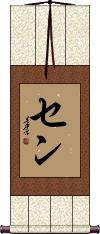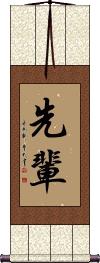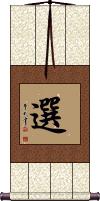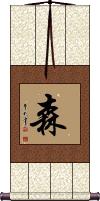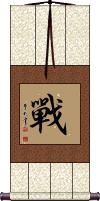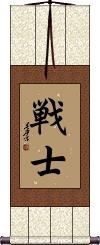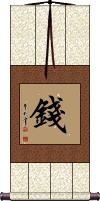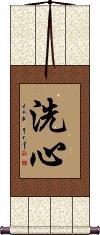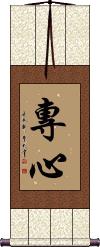Many custom options...
And formats...

The name Sen in Chinese / Japanese...
Buy a Sen calligraphy wall scroll here!
Personalize your custom “Sen” project by clicking the button next to your favorite “Sen” title below...
1. Sen
2. Senpai / The Elder or Master
4. Forest
5. War
7. Money
8. Purified Spirit / Enlightened Attitude
9. Clairvoyance
10. One Day Seems Like 1000 Years
11. Time is Gold
12. Devotion / Dedication / Attentive / Focused
13. Diversity
Senpai / The Elder or Master
先輩 is a Chinese, Japanese, and old Korean word or title that means elders, senior (at work or school), superior, older graduate, progenitor, or old-timer.
In American dojos, this is sometimes romanized as Sempai.
Choice / Choose / Select
This single Chinese character, old Korean Hanja, and Japanese Kanji means: to choose; to pick; to select; to elect; selection; choice; choosing; picking; election.
In Japanese, it can also be the male given name Hitoshi.
In the Buddhist context, it means to choose, or a myriad.
Forest
森 is the Chinese, Japanese Kanji, and old Korean Hanja for forest.
This can also refer to a dense forest-like place or thing. It can also refer to a shrine grove or sacred grove (a forest of religious significance).
戰 means war, battle, or fight.
戰 is often used to title various wars. For instance, if you add the character for “2” before this character, you have the Chinese title for WWII.
In certain contexts, someone can use this word to mean campaign, game, or match.
Written as 戦 in modern Japanese.
![]() Note: In Japan, they tend to use the form shown to the right. If you pick the Japanese master calligrapher, you may get/request this version. It should also be noted that this Kanji is seldom used alone in Japanese.
Note: In Japan, they tend to use the form shown to the right. If you pick the Japanese master calligrapher, you may get/request this version. It should also be noted that this Kanji is seldom used alone in Japanese.
Warrior / Fighter
Senshi
Money
錢 is the simplest way to say “money” in Chinese.
It can also mean cash, coins, or currency. It's also a surname, Qian, in China.
![]() This also means coins in old Korean Hanja and Japanese Kanji (though they use a slightly alternate form in Japan, as seen to the right). In both Japan and Korea, this can simply mean “one cent.”
This also means coins in old Korean Hanja and Japanese Kanji (though they use a slightly alternate form in Japan, as seen to the right). In both Japan and Korea, this can simply mean “one cent.”
![]() On the left side of this character is a radical, which means “gold” (or metal, depending on context).
On the left side of this character is a radical, which means “gold” (or metal, depending on context).
![]()
![]() On the right are two repeated radicals which currently mean “small” or “narrow” but used to kind of mean “tools” or “weapons.”
On the right are two repeated radicals which currently mean “small” or “narrow” but used to kind of mean “tools” or “weapons.”
It's a bit of a stretch, but you could suggest that money = “gold weapons” or “gold tools” in Chinese. Many Chinese people would argue otherwise depending on what they know of or the way they understand the etymology of the right side radical. I've seen some who say it means “industrialized gold,” but I take that to mean “raw gold turned into coins.”
Purified Spirit / Enlightened Attitude
A Japanese martial arts title/concept
The first Kanji alone means to wash, bathe, primness, cleanse or purify.
The second Kanji means heart, mind, soul, or essence.
Together, these two Kanji create a word defined as “purified spirit” or “enlightened attitude” within Japanese martial arts.
洗心 is one of the five spirits of the warrior (budo) and is often used as a Japanese martial arts tenet. Under that context, it's often defined as a spirit that protects and harmonizes the universe. Senshin is a spirit of compassion that embraces and serves all humanity and whose function is to reconcile discord in the world. It holds all life to be sacred. It is the Buddha mind.
This title will only be familiar to Japanese who practice certain martial arts. Others may not recognize this word at all.
洗心 does not show up as a word in too many Chinese dictionaries, but it can be read and has the same meaning in Chinese.
![]() There is an issue with the first character. The original, and probably most correct version is shown above. However, many dojo documents and other sources have used a more simple first character. Arguments ensue about which version is correct. If you want to be correct in the Japanese language, use the "Select and Customize" button above. If you want to match the Kanji used by your dojo, click the Kanji shown to the right. There is a slightly different meaning with this first character which means before, ahead, previous, future, precedence.
There is an issue with the first character. The original, and probably most correct version is shown above. However, many dojo documents and other sources have used a more simple first character. Arguments ensue about which version is correct. If you want to be correct in the Japanese language, use the "Select and Customize" button above. If you want to match the Kanji used by your dojo, click the Kanji shown to the right. There is a slightly different meaning with this first character which means before, ahead, previous, future, precedence.
Clairvoyance
One Day Seems Like 1000 Years
一日千秋 is a Japanese and Chinese proverb about missing someone.
一日千秋 is often used to express how hard it is to wait for someone's return or to be away from someone.
Some will translate this as “one day feels like a very long time” or “waiting for someone (something) is hard.”
You might see this romanized as a single word, Ichijitsusenshuu, or as “Ichijitsu Senshuu” from Japanese.
If you break down the characters one-by-one, we get:
一 = one/a
日 = day/sun (can also represent time or date)
千 = 1000/thousand
秋 = autumn/fall
Together, 千秋 can mean “autumn comes thousand times” (or 1000 years). It can also be read as 1000 periods of time.
However, it relays the idea of heartache as you wait for someone you miss.
Time is Gold
Devotion / Dedication / Attentive / Focused
專心 makes a word that means “paying attention with your heart.”
It's often translated as “dedication,” as in “be absorbed in” or “concentrate one's efforts.” It's also used to mean “with the single mind,” “whole-heartedly,” “paying attention,” “undivided attention,” “concentration (-ed),” “engrossed,” “devotionally (listening/watching),” and/or “attentive.”
The first character means “for a particular person, occasion, or purpose,” “focused on one single thing,” “concentrated,” and sometimes, “special.”
The second character means “heart” or “mind” by itself.
My favorite translation, which comes from the Oxford Advanced Chinese/English Dictionary, is, “wholehearted devotion.”
If it seems like the meaning of this word is quite open, you are correct. The context in which the word is used matters a lot. It can mean different things depending on how you use it. This makes it kind of nice as you can decide what this means to you (within some limits). This is always positive in meaning, so even if a Chinese person reads it differently than you, it will still have a good meaning.
![]() In Japanese, they tend to use a variation of the second character which has one less stroke. If you want your calligraphy written this Japanese form, please click on the Kanji shown to the right instead of the button above. Note: Japanese and Chinese people will recognize either form.
In Japanese, they tend to use a variation of the second character which has one less stroke. If you want your calligraphy written this Japanese form, please click on the Kanji shown to the right instead of the button above. Note: Japanese and Chinese people will recognize either form.
Diversity
千差萬別 is used to describe “manifold diversity.”
It literally means “A thousand differences and ten thousand distinctions.”
Other translations include an infinite variety of; multifarious; being extremely varied and wide-ranging.
The third character is written differently in Japanese, so if you order this from the Japanese master calligrapher it will look like 千差万別 instead of 千差萬別.
Not the results for Sen that you were looking for?
Below are some entries from our dictionary that may match your Sen search...
| Characters If shown, 2nd row is Simp. Chinese |
Pronunciation Romanization |
Simple Dictionary Definition |
森 see styles |
sēn sen1 sen morihama もりはま |
More info & calligraphy: Sen(1) forest; (2) shrine grove; (surname) Morihama Dense, forest-like. |
埃森 see styles |
āi sēn ai1 sen1 ai sen |
More info & calligraphy: Esem |
拉森 see styles |
lā sēn la1 sen1 la sen |
More info & calligraphy: Larsen |
梅森 see styles |
méi sēn mei2 sen1 mei sen umemori うめもり |
More info & calligraphy: Mayson(surname) Umemori |
森林 see styles |
sēn lín sen1 lin2 sen lin moribayashi もりばやし |
More info & calligraphy: Forest(noun - becomes adjective with の) forest; woods; (surname) Moribayashi |
漢森 汉森 see styles |
hàn sēn han4 sen1 han sen |
More info & calligraphy: Hansen |
詹森 see styles |
zhān sēn zhan1 sen1 chan sen |
More info & calligraphy: Jensen |
阿森 see styles |
ā sēn a1 sen1 a sen |
More info & calligraphy: Arsen |
喬納森 乔纳森 see styles |
qiáo nà sēn qiao2 na4 sen1 ch`iao na sen chiao na sen |
More info & calligraphy: Jonathon |
尼克森 see styles |
ní kè sēn ni2 ke4 sen1 ni k`o sen ni ko sen |
More info & calligraphy: Nixon |
尼爾森 尼尔森 see styles |
ní ěr sēn ni2 er3 sen1 ni erh sen |
More info & calligraphy: Nielsen |
弗格森 see styles |
fú gé sēn fu2 ge2 sen1 fu ko sen |
More info & calligraphy: Ferguson |
森林浴 see styles |
sēn lín yù sen1 lin2 yu4 sen lin yü shinrinyoku しんりんよく |
More info & calligraphy: Forest Bathingforest bathing; forest therapy; peaceful walk through the woods for health benefits |
湯普森 汤普森 see styles |
tāng pǔ sēn tang1 pu3 sen1 t`ang p`u sen tang pu sen |
More info & calligraphy: Thompson |
皮爾森 皮尔森 see styles |
pí ěr sēn pi2 er3 sen1 p`i erh sen pi erh sen |
More info & calligraphy: Pearson |
盧森堡 卢森堡 see styles |
lú sēn bǎo lu2 sen1 bao3 lu sen pao |
More info & calligraphy: Luxembourg |
辛普森 see styles |
xīn pǔ sēn xin1 pu3 sen1 hsin p`u sen hsin pu sen |
More info & calligraphy: Simpson |
槮 椮 see styles |
sēn sen1 sen |
lush growth (trees); fishing using bundled wood (archaic) |
林森 see styles |
lín sēn lin2 sen1 lin sen hayashimori はやしもり |
Lin Sen (1868-1943), revolutionary politician, colleague of Sun Yat-sen, chairman of the Chinese nationalist government (1928-1932) (surname) Hayashimori |
森嚴 森严 see styles |
sēn yán sen1 yan2 sen yen |
strict; rigid; tight (security) |
森森 see styles |
sēn sēn sen1 sen1 sen sen shinshin しんしん |
dense (of trees); thick; ghastly; eerie (noun or adjectival noun) deeply forested |
森然 see styles |
sēn rán sen1 ran2 sen jan |
(of tall trees) dense, thick; awe-inspiring |
森田 see styles |
sēn tián sen1 tian2 sen t`ien sen tien moruta もるた |
Morita (Japanese surname) (personal name) Moruta |
森羅 森罗 see styles |
sēn luó sen1 luo2 sen lo morira もりら |
many things arranged together, or connected together; to go on limitlessly (surname) Morira many things arranged together |
楊森 杨森 see styles |
yáng sēn yang2 sen1 yang sen |
Yang Sen (1884-1977), Sichuan warlord and general |
洪森 see styles |
hóng sēn hong2 sen1 hung sen |
Hun Sen (1952-), prime minister of Cambodia since 1985 |
藤森 see styles |
téng sēn teng2 sen1 t`eng sen teng sen fujimori ふじもり |
Fujimori (Japanese surname); Alberto Ken'ya Fujimori (1938-), president of Peru 1990-2000 (place-name, surname) Fujimori |
陰森 阴森 see styles |
yīn sēn yin1 sen1 yin sen |
gloomy; sinister; eerie |
青森 see styles |
qīng sēn qing1 sen1 ch`ing sen ching sen aomori あおもり |
Aomori prefecture at the far north of Japan's main island Honshū 本州[Ben3 zhou1] Aomori (city, prefecture); (place-name, surname) Aomori |
亞松森 亚松森 see styles |
yà sōng sēn ya4 song1 sen1 ya sung sen |
Asunción, capital of Paraguay |
Click here for more Sen results from our dictionary
The following table may be helpful for those studying Chinese or Japanese...
| Title | Characters | Romaji (Romanized Japanese) | Various forms of Romanized Chinese | |
| Sen | セン | sen | ||
| Senpai The Elder or Master | 先輩 先辈 | sen pai / senpai | xiān bèi / xian1 bei4 / xian bei / xianbei | hsien pei / hsienpei |
| Choice Choose Select | 選 选 | sen | xuǎn / xuan3 / xuan | hsüan |
| Forest | 森 | mori | sēn / sen1 / sen | |
| War | 戰 / 戦 战 | sen | zhàn / zhan4 / zhan | chan |
| Warrior Fighter | 戦士 | sen shi / senshi | ||
| Money | 錢 / 銭 钱 | sen | qián / qian2 / qian | ch`ien / chien |
| Purified Spirit Enlightened Attitude | 洗心 先心 | sen shin / senshin | xǐ xīn / xi3 xin1 / xi xin / xixin | hsi hsin / hsihsin |
| Clairvoyance | 千里眼 | sen ri gan / senrigan | qiān lǐ yǎn qian1 li3 yan3 qian li yan qianliyan | ch`ien li yen chienliyen chien li yen |
| One Day Seems Like 1000 Years | 一日千秋 | ichi jitsu sen shuu ichijitsusenshuu ichi jitsu sen shu | yí rì qiān qiū yi2 ri4 qian1 qiu1 yi ri qian qiu yiriqianqiu | i jih ch`ien ch`iu ijihchienchiu i jih chien chiu |
| Time is Gold | 一刻千金 | ikko ku sen kin ikkokusenkin iko ku sen kin | yī kè qiān jīn yi1 ke4 qian1 jin1 yi ke qian jin yikeqianjin | i k`o ch`ien chin ikochienchin i ko chien chin |
| Devotion Dedication Attentive Focused | 專心 / 専心 / 耑心 专心 | sen shin / senshin | zhuān xīn zhuan1 xin1 zhuan xin zhuanxin | chuan hsin chuanhsin |
| Diversity | 千差萬別 千差万别 / 千差万別 | sen sa man betsu sensamanbetsu | qiān chā wàn bié qian1 cha1 wan4 bie2 qian cha wan bie qianchawanbie | ch`ien ch`a wan pieh chienchawanpieh chien cha wan pieh |
| In some entries above you will see that characters have different versions above and below a line. In these cases, the characters above the line are Traditional Chinese, while the ones below are Simplified Chinese. | ||||
Successful Chinese Character and Japanese Kanji calligraphy searches within the last few hours...
